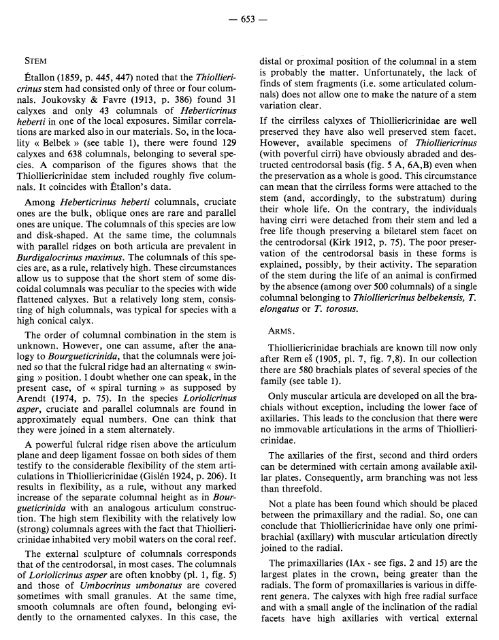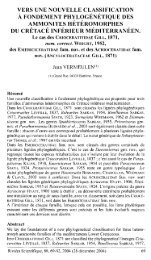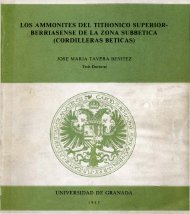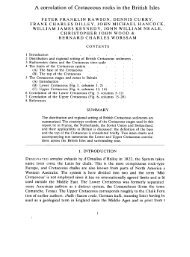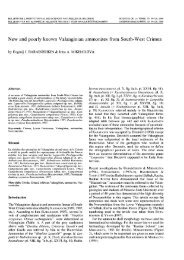thiolliericrinid crinoids from the lower cretaceous of crimea
thiolliericrinid crinoids from the lower cretaceous of crimea
thiolliericrinid crinoids from the lower cretaceous of crimea
You also want an ePaper? Increase the reach of your titles
YUMPU automatically turns print PDFs into web optimized ePapers that Google loves.
St e mÉtallon (1859, p. 445, 447) noted that <strong>the</strong> Thiolliericrinusstem had consisted only <strong>of</strong> three or four columnals.Joukovsky & Favre (1913, p. 386) found 31calyxes and only 43 columnals <strong>of</strong> Heberticrinusheberti in one <strong>of</strong> <strong>the</strong> local exposures. Similar correlationsare marked also in our materials. So, in <strong>the</strong> locality« Belbek » (see table 1), <strong>the</strong>re were found 129calyxes and 638 columnals, belonging to several species.A comparison <strong>of</strong> <strong>the</strong> figures shows that <strong>the</strong>Thiolliericrinidae stem included roughly five columnals.It coincides with Étallon’s data.Among Heberticrinus heberti columnals, cruciateones are <strong>the</strong> bulk, oblique ones are rare and parallelones are unique. The columnals <strong>of</strong> this species are lowand disk-shaped. A t <strong>the</strong> same time, <strong>the</strong> columnalswith parallel ridges on both articula are prevalent inBurdigalocrinus maximus. The columnals <strong>of</strong> this speciesare, as a rule, relatively high. These circumstancesallow us to suppose that <strong>the</strong> short stem <strong>of</strong> some discoidalcolumnals was peculiar to <strong>the</strong> species with wideflattened calyxes. But a relatively long stem, consisting<strong>of</strong> high columnals, was typical for species with ahigh conical calyx.The order <strong>of</strong> columnal combination in <strong>the</strong> stem isunknown. However, one can assume, after <strong>the</strong> analogyto Bourgueticrinida, that <strong>the</strong> columnals were joinedso that <strong>the</strong> fulcral ridge had an alternating « swinging» position. I doubt whe<strong>the</strong>r one can speak, in <strong>the</strong>present case, <strong>of</strong> « spiral turning » as supposed byA rendt (1974, p. 75). In <strong>the</strong> species Loriolicrinusasper, cruciate and parallel columnals are found inapproximately equal numbers. One can think that<strong>the</strong>y were joined in a stem alternately.A powerful fulcral ridge risen above <strong>the</strong> articulumplane and deep ligament fossae on both sides <strong>of</strong> <strong>the</strong>mtestify to <strong>the</strong> considerable flexibility <strong>of</strong> <strong>the</strong> stem articulationsin Thiolliericrinidae (Gislén 1924, p. 206). Itresults in flexibility, as a rule, without any markedincrease <strong>of</strong> <strong>the</strong> separate columnal height as in Bourgueticrinidawith an analogous articulum construction.The high stem flexibility with <strong>the</strong> relatively low(strong) columnals agrees with <strong>the</strong> fact that Thiolliericrinidaeinhabited very mobil waters on <strong>the</strong> coral reef.The external sculpture <strong>of</strong> columnals correspondsthat o f <strong>the</strong> centrodorsal, in most cases. The columnals<strong>of</strong> Loriolicrinus asper are <strong>of</strong>ten knobby (pl. 1, fig. 5)and those <strong>of</strong> Umbocrinus umbonatus are coveredsometimes with small granules. At <strong>the</strong> same time,smooth columnals are <strong>of</strong>ten found, belonging evidentlyto <strong>the</strong> ornamented calyxes. In this case, <strong>the</strong>distal or proximal position <strong>of</strong> <strong>the</strong> columnal in a stemis probably <strong>the</strong> matter. Unfortunately, <strong>the</strong> lack <strong>of</strong>finds <strong>of</strong> stem fragments (i.e. some articulated columnals)does not allow one to make <strong>the</strong> nature <strong>of</strong> a stemvariation clear.If <strong>the</strong> cirriless calyxes <strong>of</strong> Thiolliericrinidae are wellpreserved <strong>the</strong>y have also well preserved stem facet.However, available specimens <strong>of</strong> Thiolliericrinus(with poverful cirri) have obviously abraded and destructedcentrodorsal basis (fig. 5 A, 6A,B) even when<strong>the</strong> preservation as a whole is good. This circumstancecan mean that <strong>the</strong> cirriless forms were attached to <strong>the</strong>stem (and, accordingly, to <strong>the</strong> substratum) during<strong>the</strong>ir whole life. On <strong>the</strong> contrary, <strong>the</strong> individualshaving cirri were detached <strong>from</strong> <strong>the</strong>ir stem and led afree life though preserving a biletarel stem facet on<strong>the</strong> centrodorsal (Kirk 1912, p. 75). The poor preservation<strong>of</strong> <strong>the</strong> centrodorsal basis in <strong>the</strong>se forms isexplained, possibly, by <strong>the</strong>ir activity. The separation<strong>of</strong> <strong>the</strong> stem during <strong>the</strong> life <strong>of</strong> an animal is confirmedby <strong>the</strong> absence (among over 500 columnals) <strong>of</strong> a singlecolumnal belonging to Thiolliericrinus belbekensis, T.elongatus or T. torosus.A r m s .Thiolliericrinidae brachials are known till now onlyafter Rem e!s (1905, pi. 7, fig. 7,8). In our collection<strong>the</strong>re are 580 brachials plates <strong>of</strong> several species <strong>of</strong> <strong>the</strong>family (see table 1).Only muscular articula are developed on all <strong>the</strong> brachialswithout exception, including <strong>the</strong> <strong>lower</strong> face <strong>of</strong>axillaries. This leads to <strong>the</strong> conclusion that <strong>the</strong>re wereno immovable articulations in <strong>the</strong> arms <strong>of</strong> Thiolliericrinidae.The axillaries <strong>of</strong> <strong>the</strong> first, second and third orderscan be determined with certain among available axillarplates. Consequently, arm branching was not lessthan threefold.Not a plate has been found which should be placedbetween <strong>the</strong> primaxillary and <strong>the</strong> radial. So, one canconclude that Thiolliericrinidae have only one primibrachial(axillary) with muscular articulation directlyjoined to <strong>the</strong> radial.The primaxillaries (IAx - see figs. 2 and 15) are <strong>the</strong>largest plates in <strong>the</strong> crown, being greater than <strong>the</strong>radiais. The form <strong>of</strong> promaxillaries is various in differentgenera. The calyxes with high free radial surfaceand with a small angle <strong>of</strong> <strong>the</strong> inclination <strong>of</strong> <strong>the</strong> radialfacets have high axillaries with vertical external


